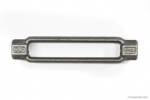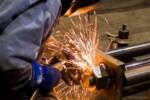Technical FAQs

Beveled Washer Slope
How do I calculate the slope in degrees for a beveled washer?The slope of a beveled washer or a given segment represents how much the elevation changes over a certain distance. The higher the slope, the more steep the incline or decline. Slope is measured in degrees, ratios and grades. To find the slope in degrees, you need to make use of trigonometry ratios or more... Read more

High Strength Turnbuckles
When designing vertical rod bracing system I would like to use F1554 grade 55 rod to achieve smaller diameters. But if I use a turnbuckle I am limited to the safe working load of that turnbuckle. Is there a higher capacity turnbuckle available?You are correct that your capacity would be limited by the safe working load of the turnbuckle, but it would be limited to that regardless of the grade of steel used for the bracing rod. Let’s assume you are using mild steel, A307/A36 rods. The minimum yield strength of that material is 36,000 psi. Using... Read more
Headed F1554 Anchor Bolts
Do headed F1554 anchor bolts have a standard hex head or a heavy hex head?ASTM F1554 does not specify whether the headed configuration is to be a standard hex pattern or heavy hex. There are three primary configurations covered by the ASTM F1554 specification which include straight rods, bent anchor bolts, and forged headed anchor bolts. Whether or not a headed anchor has a standard hex head or a heavy hex head can differ depending on the application. Since the... Read more
Lag Screw Torque Specifications
Are torque specifications or values available for lag screws?There are no documented torque values for lag bolts or screws. The reason for this lies in the definition of torque when discussing threaded fasteners. To put it simply, torque is a measure of the twisting force required to spin a nut up along the threads of a bolt. Lag screw threads are driven into wood, and therefore,... Read more
Anchor Bolt Pullout Strength
What is the Pullout Strength of Portland Bolt’s Anchor Bolts?This is a question that we are asked on a regular basis, and one that we do not have a clear answer for due to the variety of factors involved in making this calculation. Anchor bolt pull out strength is the force required to pull a single bolt out of its foundation. In order to... Read more
Contec vs. Wilson Sleeves
What is the difference between the two types of anchor sleeves that Portland Bolt stocks?Portland Bolt inventories two different lines of anchor bolt sleeves, Wilson and Contec. There are many similarities between the two products, with two notable differences. The two main differences between these two types of anchor bolt sleeves are in sizing and coloring. Wilson Sleeves Contec Sleeves Composition and Materials Both brands are manufactured of high... Read more

Welding High Strength Bolts
Can welding be performed on high strength anchor bolts and fasteners?The short answer is that in most cases, welding high strength bolts is not allowed. In the fastener industry, the term “high strength” typically refers to any medium carbon or alloy steel which undergoes a heat-treating process to develop the strength properties necessary to meet the requirements of a given specification. These ASTM specifications include... Read more
Rolled vs Cut Thread Bolts
What is the difference between a bolt with rolled threads and one with cut threads and does a fastener with a reduced body and rolled threads meet ASTM specifications?Threads of a mechanical fastener, regardless of whether it is a headed bolt, rod, or bent bolt, can be produced by either cutting or rolling. The differences, misconceptions, advantages, and disadvantages of each method are described below. Rolled Threads Roll threading is a process by which steel is extruded to form the threaded portion of... Read more
Large Diameter SAE Bolts
Are SAE Grade 2, 5, and 8 bolts available in diameters over 1½"?No, the SAE J429 specification only covers bolts up to and including 1½” diameter. SAE J429 (1999), the specification that includes Grade 2, 5, and 8 fasteners, states: “This SAE standard covers the mechanical and material requirements for inch-series steel bolts, screws, studs, SEMS, and U-bolts used for automotive and related industries in sizes to... Read more
Calculating Yield & Tensile Strength
How do I determine the yield and tensile strength of a specific diameter of bolt?In most cases, the strength of a given material used to make a fastener has strength requirements or parameters described as pounds per square inch (psi) or thousands of pounds per square inch (ksi). This is helpful when analyzing what grade of material should be used for a given application, but this doesn’t tell us... Read more
